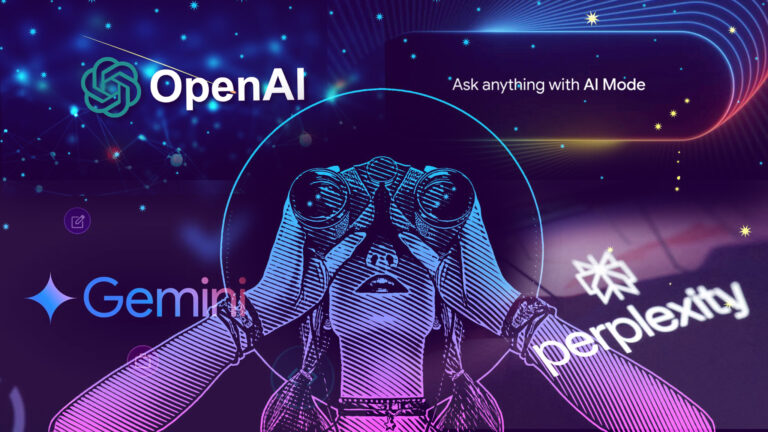Search is no longer just about showing up. It’s about showing up in the right way.
As AI-powered search tools like Google AI Overviews, Perplexity, and ChatGPT Search rewrite how people discover information, businesses need to rethink their SEO strategies. Ranking #1 is no longer enough. If your content isn’t optimised for AI, you may not show up at all.
Enter two emerging disciplines: Generative Engine Optimisation (GEO) and Answer Engine Optimisation (AEO).
Together, they represent the next evolution of SEO and the key to keeping your business visible in an AI-first world.
What is Generative Engine Optimisation (GEO)?
GEO is the practice of making your content “AI-friendly.” It’s about structuring and writing content so that large language models (LLMs) like ChatGPT, Claude, and Gemini can understand it, trust it, and use it when generating answers.
Instead of targeting only search crawlers, GEO ensures your content is:
- Clear: Short, simple explanations are easier for AI to repurpose.
- Context-rich: Provide depth and nuance, not thin keyword-stuffed pages.
- Well-sourced: AI looks for citations, include data, references, and credible sources.
Example: Instead of a vague page titled “Consulting Services,” write “Management Consulting Services for Mid-Sized Businesses” with FAQs, case studies, and structured service details.
What is Answer Engine Optimisation (AEO)?
While GEO is about being AI-readable, AEO is about becoming the actual answer.
Answer engines like Perplexity and Google AI Overviews don’t want to send users off on a click trail, they want to give them what they need immediately. AEO ensures your content is chosen to fill that answer box.
Key elements of AEO:
- Q&A format: Use headings that mirror natural queries (e.g. “What is change management in consulting?”).
- Schema markup: Add structured data (FAQ, HowTo, Product, Review) so AI knows how to parse your page.
- Conversational language: Optimise for how people actually ask questions, not how they type keywords.
Example: A consulting firm might create a FAQ page with “What is organisational change management?” and a 2–3 sentence, jargon-free answer. That makes it more likely to be surfaced in an AI-generated summary.
Why traditional SEO isn’t enough
For decades, SEO was about pleasing Google’s algorithm:
- Keywords in the right places.
- Backlinks to build authority.
- Mobile speed for usability.
That’s still relevant, but AI search tools add another layer. They’re not just ranking sites; they’re deciding which parts of your content to summarise.
According to Cybernews, AI bots are now crawling websites hundreds of times more than they send traffic. In other words: your content may be fuelling AI answers without you seeing the clicks.
The way forward? GEO and AEO.
How GEO and AEO work together
Think of GEO and AEO as two halves of the same strategy:
- GEO makes your content AI-readable.
→ Clean, structured, authoritative. - AEO makes your content AI-usable.
→ Q&A style, schema, directly answering questions.
Together, they ensure that when AI search engines look for answers, your content is both understandable and the chosen response.
Practical steps for GEO & AEO
Here’s how to start implementing both today:
Step 1: Reframe content in Q&A style
- Use H2/H3 headings written as natural questions.
- Provide short, clear answers (2–3 sentences) under each.
Step 2: Add structured data
- Use FAQ schema for Q&A pages.
- Use HowTo schema for step-by-step guides.
- Use Review schema for testimonials and case studies.
Step 3: Improve topical authority
- Build content clusters around core themes.
- Example: A consulting firm could have a cluster around “change management” with blogs, FAQs, and case studies all linked internally.
Step 4: Prioritise trust signals
- Cite authoritative external sources like McKinsey or Harvard Business Review.
- Publish case studies with real-world examples.
Step 5: Optimise for conversational search
- Use tools like Answer the Public or AlsoAsked to find real questions.
- Write content the way people speak—not the way marketers write.
Example scenario: B2B consulting firm
Let’s say you run a Sydney-based engineering consultancy.
- Old SEO: Target “engineering consulting Sydney” with a services page.
- With GEO/AEO:
- Add a FAQ: “What does an engineering consultant do?”
- Create a blog: “How engineering consultants help infrastructure projects avoid delays.”
- Use schema markup to highlight services and case studies.
When someone types into Perplexity, “Best engineering consultants in Sydney for infrastructure projects,” your structured, authoritative content stands a much better chance of being cited in the summary.
Pitfalls to avoid
- Keyword stuffing – AI engines are smart enough to ignore fluff.
- Thin content – Pages with 200 words won’t cut it; depth matters.
- Ignoring schema – Without structured data, AI may misinterpret your content.
- Copycat content – If your article looks like everyone else’s, why would AI pick you?
The future of search visibility
Generative and answer engines are just the beginning. As Wikipedia’s page on Generative Engine Optimisation notes, this field is evolving quickly, and those who adapt early will gain a competitive edge.
Soon, Agentic AI Optimisation (AAIO) may become just as important, as AI agents begin to act on behalf of users. GEO and AEO are the foundation for preparing your digital presence for that future.
The bottom line
Search is no longer about climbing rankings – it’s about becoming the answer.
By embracing Generative Engine Optimisation and Answer Engine Optimisation, your business can stay visible, trusted, and relevant in an AI-first world.
At Redfox Digital, we specialise in building websites and digital ecosystems that aren’t just optimised for today, but for what’s next.
Want to know if your content is AI-ready? Let’s talk: https://www.redfox.digital/contact


